Letters from Lodi
An insightful and objective look at viticulture and winemaking from the Lodi
Appellation and the growers and vintners behind these crafts. Told from the
perspective of multi-award winning wine journalist, Randy Caparoso.
The 9,000-year history of Vitis vinifera, emerging from the genetic mixture of domesticated and wild grapes

Ancient Mediterranean winery: Artist's rendering (top) of a large volume Phoenician winemaking facility, dated back over 2,600 years ago, recently excavated in Lebanon.
Lodi is a warm-climate wine-growing region. We usually use the term "Mediterranean Climate" to describe Lodi's climate because, to begin with, the Mediterranean Basin itself (stretching from Spain and Southern France through Italy, Greece, and the Middle East) is a vast winegrowing region, producing countless wines of amazing quality and diversity. If a Mediterranean climate was always good enough for the ancient wine regions encircling the Mediterranean Sea, it certainly is good enough for a region like Lodi.
Mediterranean as a climatic term also more readily explains why, despite the region's relatively higher temperatures, Lodi still produces red wines with fresh, vivid fruit aromas and gentle, often even delicate palate structures (when you say "warm" or "hot" climate, you tend to think the opposite). White wines grown in Lodi are typically fresh in perfectly natural grape acidity and are as light and fragrant as white wines from practically anywhere else in the world. This is proven time and time again in blind tastings!

May 2023 example of an ideal winegrowing environment: are Cinsaut vines in Lodi's Mokelumne River appellation, still extremely productive after over 136 years.
Temperature, in other words, is simply not a factor that keeps Lodi from producing high-quality grapes and wines. If that were the case Lodi would not be the largest winegrowing region in the nation. Wineries would be looking elsewhere for grapes.
Finally, we love to point out that Lodi has, by far, the largest acreage of "old vines" (plants over 50 to 100 years old) in California, hence the country. No other wine region comes close. It is significant because vines prosper in one place primarily for one reason: they are growing in an environment naturally conducive to grapevine health, hence longevity. Ergo: Lodi has ideal grapevine terroir.
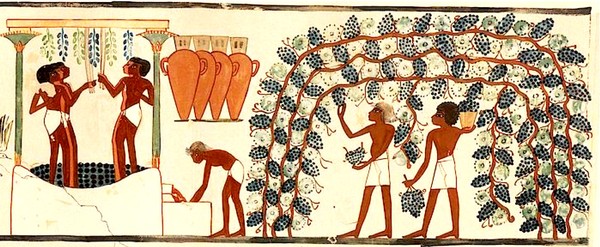
Depiction of wine grape harvest and winemaking in Egypt, where wine production has been dated back beyond 3,000 BC.
The question of the suitability of the climate for wine grapes naturally brings up the question of the ideal environment that has been historically suitable for wine grapes. Not just over the past 100 or 200 years, mind you. More like the past 8,000 or 9,000 years, which is how far back the tradition of winegrowing goes.
If, in fact, you look back at where the world's finest wine grapes originated, you find it was in parts of the world where, like Lodi, summers are consistently warm and sun-soaked; and not coincidentally, where grapes are grown near large bodies of water which moderate climatic conditions considerably easier (Lodi, of course, being completely exposed to the Pacific Ocean by the California Delta, the latter lying below sea level).
Hence, our quick dive into this deep and salient history may also teach you a thing or two about why grapes grow so easily in Lodi.
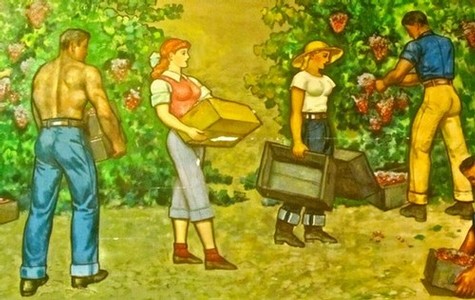
Lodi Grape Festival mural depicting the circa-1950s harvest of Flame Tokay, a pink-colored Vitis vinifera that was the most widely planted grape in the Lodi appellation for over 100 years.
The ancient origin of domesticated grapevines
There is archeological evidence in the way of winemaking residues (tartaric acid) found in clay jars unearthed in present-day Georgia (in the Caucasus region, between the Black Sea and the Caspian Sea) that humankind, a clever species, was practicing the craft of winemaking as far back as the seventh millennium BC. That's 7,000 to 6,000 years "Before Christ."
In recent years, studies of grape genomes (i.e., genetic material, or DNA) have confirmed archeological findings, demonstrating the origin of domesticated grapevines in the area known as Transcaucasia, straddling the south side of the Caucasus Mountains where Eastern Europe and Western Asia meet. This region roughly corresponds with the present-day countries of Armenia, Georgia, and Azerbaijan.

Transcaucasia (the southern reaches of the Caucasus Mountains) between the Black Sea and the Caspian Sea, where most likely the first wine grape (Vitis vinifera) was domesticated, specifically for winemaking.
There are two things to understand first, regarding the origins of wine grapes:
1. What is a domesticated grapevine?
2. What single species of grape is associated with the domesticated plant?
Answer to the second question: Vitis vinifera. This is the species that produces the fruit going into all the wines considered to be the finest in the world—including individuals cultivars such as Cabernet Sauvignon, Merlot, Pinot noir, Syrah, Chardonnay, Sauvignon blanc, Riesling, Zinfandel, Sangiovese, Tempranillo, et al. In addition, most of the world's major table and raisin grapes, such as Sultana (a.k.a., Thompson Seedless) and Muscat, belong to the Vitis vinifera family, as did Lodi's historic Flame Tokay.
Answer to the first question: The grapevine was considered domesticated once it made the transition from a wild ancestry—species collectively called Vitis vinifera sylvestris—and began to be propagated for specific purposes primarily having to do preference of berry size and sweetness, the fruit attributes that consistently produce superior wine.
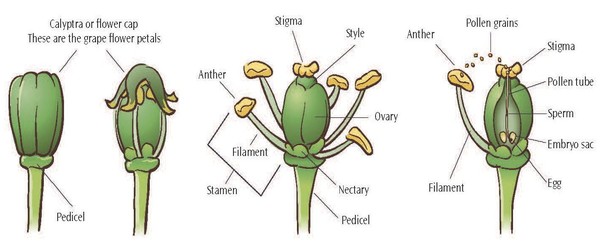
The hermaphrodite (i.e., self-pollinating) morphology of the Vitis vinifera flower: (from left) cap, full bloom (ovary and stamens), and pollination and fertilization leading to fruit set.
A major difference between wild grapevines (vinifera sylvestris) and domesticated grapevines (vinifera) is that wild plants are dioecious—meaning, male and female flowers are found on separate plants, thus requiring cross-pollination to produce fruit. Vitis vinifera as a species was selected by the earliest grapevine farmers because it is a hermaphrodite genotype, possessing both staminate (male) and pistillate (female) organs in its flower, thus allowing self-pollination—a distinct advantage when it came to the achievement of consistency of fruit quality characteristics.
A second element of domestication is that propagation of Vitis vinifera became vegetative—primarily through the rooting of cuttings, or by grafting whenever farmers wished to change the identity of a cultivar without having to uproot an existing plant. This is opposed to propagation by seed, which never guarantees the exact same result because seeds contain the genetic information of multiple parent varieties. Simply put: If you pop a grape seed into the ground, you never know what you'll end up with (although a couple of more adventurous California vintners have experimented with this over the past decade and a half—the significance of their projects, akin to jousting at windmills, remain to be seen).
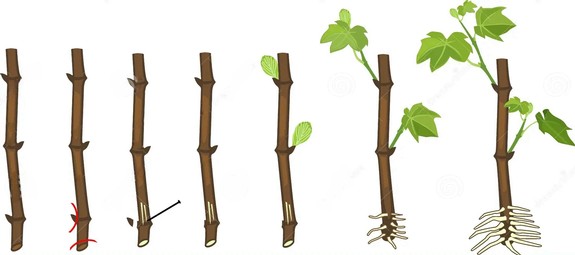
The vegetative propagation of grapevine cuttings devised by winegrowers over 8,000 years ago. dreamstime.com.
The proliferation of Vitis vinifera
Both archeological and genetic studies of existing wine grapes point to the establishment of one original cultivar of Vitis vinifera emerging in the South Caucasus region over 8,000 years ago; although there are also schools of thought that postulate that this may have happened somewhere within the broader Fertile Crescent or Levant (the Middle East regions spanning present-day Iraq, Syria, Lebanon, Israel, Palestine, Jordan and parts of Turkey, Iran, and Egypt).
Yet, obviously, today's global wine industry is replete with an enormous range of wine grape varieties belonging to Vitis vinifera, which have numbered up to 10,000. The master volume on wine grapes is called, plainly enough, Wine Grapes, by Jancis Robinson, Julia Harding, and José Vouillamoz. The book is subtitled A Complete Guide to 1,368 Vine Varieties, including Their Origins and Flavours—in reference to the authors' intention of covering only the varieties of significant commercial value. The fact that they ended up with 1,368 grapes to talk about tells you how much the Vitis vinifera species has expanded over the past 9,000 years.

There are numerous papers found online that provide a basic timeline and geographical progression of this proliferation. In Science News (December 21, 2021), Enrico de Lazaro recently summarized some of the latest findings in his report entitled European Wine Grapes Originated in Western Asia:
Studies suggest that grapes originated from a single domestication event in western Asia, most likely in the South Caucasus, followed by multiple rounds of inter-breeding with the European wild grape population. They also identified the genetic footprints for domestication and breeding selection, which determine the grapes used for today’s winemaking.

Late 1800s photo of Georgia vintner with qveri, large clay pots utilized for fermentation and aging of wines in the Transcaucasia region for thousands of years, and being revived today.
Mr. de Lazaro goes on to describe how similar levels of genetic diversity are being found in both wild grapes and the varieties used in today's wine world, suggesting the way in which all the varieties of Vitis vinifera developed over time:
[The single domestication event originating in western Asia] was followed by numerous and pervasive introgressions [i.e., transfer of genetic information from one species to another] from European wild populations... This admixture generated the so-called international wine grapes that have diffused from Alpine countries worldwide.
Across Europe, marked differences in genomic [i.e., sets of DNA] diversity are observed in local varieties that are traditionally cultivated in different wine-producing countries, with Italy and France showing the largest diversity. Three genomic regions of reduced genetic diversity are observed, presumably as a consequence of artificial selection.
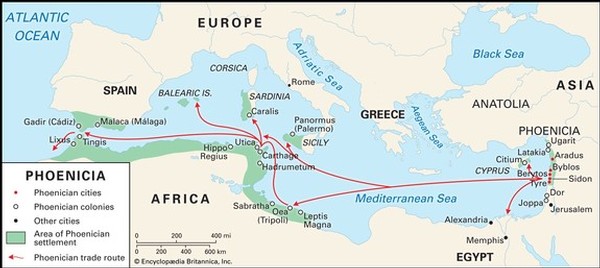
The direct impact of the Phoenician civilization at its height between 1,100 and 200 BC, expanded the proliferation of Vitis vinifera.
In other words, the difference in morphology (i.e., the structure of organisms) that makes, say, a Cabernet Sauvignon distinct from a Pinot noir or Sangiovese came about as a result of Vitis vinifera varieties' absorption of genetic contributions from local populations of wild grape vines (i.e., Vitis vinifera sylvestris), wherever vinifera was planted as it spread across Western Europe.
In the 2022 paper entitled The Rise of Wine among Ancient Civilizations across the Mediterranean Basin (Harutyunyan, Malfeito-Ferrira), a rough timeline of the westward expansion of wine grape cultivation is summarized as such:
► 7,200 to 4,000 BC—Original cultivation of Vitis vinifera in the Near East and Levant
► 6,400 to 2,200 BC—Arrival in Greece and Crete
► 3,150 to 1,300 BC—Egypt
► 2,000 to 900 BC—Italy
► 800 to 200 BC—Spain
► 500 to 400 BC—France
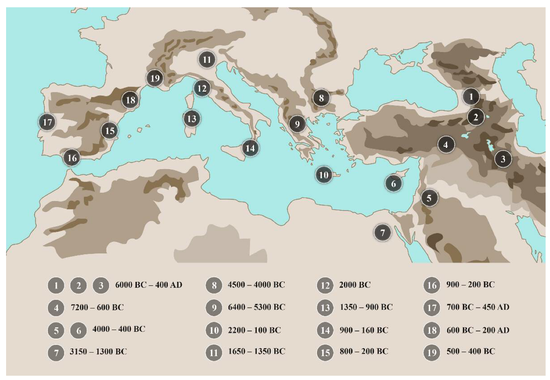
The historical spread of Vitis vinifera from the Near East across Western Europe. The Rise of Wine among Ancient Civilizations across the Mediterranean Basin (Harutyunyan, Malfeito-Ferrira).
A 2006 study of genetic relationships of grapes published by Molecular Ecology entitled Multiple origins of cultivated grapevine (Vitis vinifera L. ssp. sativa) based on chloroplast DNA polymorphisms confirms the hypothesis that sylvestris germplasm (i.e., genetic resources of wild grapes, including seeds, tissues, and DNA sequences) contributed directly to multiple domestication events over several thousand years, as winegrowing spread across Western Europe from its cradle in the Near East:
The analysis of genetic relationships of both sativa [i.e. Vitis vinifera) and sylvestris subspecies support the existence of an important contribution of wild sylvestris germplasm from the Near East and Western Europe to the origin of current Eurasian cultivars. These results suggest the existence of at least two origins for grapevine cultivars, one in the Near East and a second one in the western Mediterranean region that gave rise to many of the Western European cultivars... Indeed, over 70% of the Iberian Peninsula cultivars display clonotypes (i.e., mixtures of DNA) that are only compatible with their having derived from western sylvestris populations.

Savagnin (not to be confused with Sauvignon Blanc), grown in France's Jura region, is considered one of the ancestral varieties of Vitis vinifera, having a first-degree genetic relationship with as many as 20 distinct varieties.
de Lazaro cites examples of cultivars resulting from the inter-breeding of Vitis vinifera coming out of the East with local European wild grape populations, based upon studies of genetic footprints:
Paleogenomic evidence supports a very early adoption of vegetative propagation and an ancient origin of some of the currently cultivated varieties, with Savagnin blanc [not to be confused with Sauvignon blanc] being at least 900 years old... Western European varieties are the foundation of the global wine industry, with ten varieties (Cabernet Sauvignon, Merlot, Tempranillo, Airén, Chardonnay, Syrah, Grenache, Sauvignon blanc, Pinot noir, Trebbiano Toscano) accounting for 26% of the vineyards worldwide.
Close relationships of today's major cultivars
The 2011 research entitled Genetic Structure and Domestication of the Grape (Myles, Boyko, Owens, Buckler) goes into a little more detail on the relationship between the primary cultivars of Vitis vinifera dominant in the wine industry today. These authors observe that while vegetative propagation was a key to domestication, "it also discouraged the generation of unique cultivars through crosses," focusing instead on crosses "among elite cultivars." That is a relatively small number of closely related varieties that consistently performed the best for early winegrowers.

Gouais blanc, another ancestral variety of Vitis vinifera that has parental ties to 16 other varieties, including Chardonnay.
Write the authors:
Based on morphological and genetic evidence, it has been suggested that Western European vinifera cultivars experienced introgression from local Western European sylvestris. Our finding that western vinifera are more closely related to western sylvestris than are other vinifera populations is consistent with gene flow between wild and cultivated grapes in Western Europe
Consequently, in their analysis of genotypes, they make a few conclusions while citing some examples:
The pedigree structure of vinifera is characterized primarily by first-degree relationships between grapes of the same type: 89.3% of edges in the network connect table grapes to table grapes or wine grapes to wine grapes... We infer that about half (47.6%) of the first-degree relationships in our sample are likely parent-offspring. The other half (52.4%) we refer to as “sibling or equivalent,” because complex crossing schemes can generate IBD values that are indistinguishable from our data from sibling relationships.
This is consistent with the previous finding that Pinot and Gouais blanc are the parents of 16 common French cultivars... The most highly connected wine grape in the present sample is Traminer [a.k.a., Savagnin], which has 20 first-degree relatives and is believed to be an ancient cultivar widely used during the history of grape breeding
Particularly noteworthy is our discovery that Chenin blanc and Sauvignon blanc are likely siblings and both share a parent-offspring relationship with Traminer. Also, we find that two of the most common cultivars of the Rhône Valley in France, Viognier, and Syrah, are likely siblings.

The close, almost incestuous, relationships between distinct varieties of Vitis vinifera have evolved over the past 3,000 years as the species proliferated in regions of Western Europe. Genetic structure and domestication of the grape (Myles, Boyko, Owens, Buckler).
In other words, most of the major varieties of Vitis vinifera are much more closely related than commonly thought, despite wide-ranging outward variations of skin color and flavor profile. They are, in fact, a gene pool of incestuous relationships. For good (they certainly make a wide range of great wine!) or bad (this means limitations in terms of adaptation to adverse terroirs or climatic events—the major one now being climate change).
In fact, a very recent paper (published this past April 2023) entitled Ancient DNA from a lost Negev Highlands desert grape reveals a Late Antiquity wine lineage points out that the modern-day global wine industry is "heavily reliant on a limited number of European grape cultivars."

Graphic demonstrating the crossing of Sauvignon Blanc and Cabernet Franc that gave rise to Cabernet Sauvignon sometime during the 1600s. marronaia.com.
The issue, write the authors:
Of the thousands of extant winemaking grape varieties, only 11 cultivars of European origin (Cabernet Sauvignon, Chasselas, Chardonnay, Grenache, Merlot, Monastrell [a.k.a., Mourvèdre], Pinot noir, Riesling, Sauvignon blanc, Syrah, and Ugni blanc [a.k.a., Trebbiano] cover more than a third of the winemaking vineyards worldwide. This remarkably small number of cultivars is grown across a relatively narrow geographic zone with generally fixed sets of climatic conditions, exposing the winemaking industry to stressors like global warming.
A recent study found that a rise of 2° C. in worldwide median temperatures would devastate grapevine cultivation in more than half of the current winegrowing areas. This is supported by increasing evidence that temperature changes affect grapevine maturation time, impacting berry and wine quality. An increase in diversity would most likely mitigate this effect and may even reverse it.

Rare sighting of Sultana (a.k.a., Thompson Seedless) in Lodi; a cultivar of Vitis vinifera introduced to California by Stockton's George West when he first established El Pinal nursery in 1852, becoming the state's leading raisin crop (although also used as a table grape and for wine).
If anything, they continue:
[Global warming] emphasizes the need for diversity in this high-impact agricultural crop... (particularly) grapevine lineages bred in hot and arid regions, often preserved over centuries, may present an alternative to the classic winemaking grape cultivars.
Will the future of the global winegrowing industry involve even more aggressive, or accelerated, human intervention than what has happened over the past 8,000 or 9,000 years? That is, further interbreeding of Vitis vinifera with grapes more genetically suitable to changing climatic conditions.
Good question... and going forth, plenty of food (or wine) for thought!

Vineyard in southern Israel's Negev Highlands, a hot, dry, arid region where genetic research is being conducted, aimed at increasing the diversity of cultivars useful to the wine industry in the event of global warming. BBC.